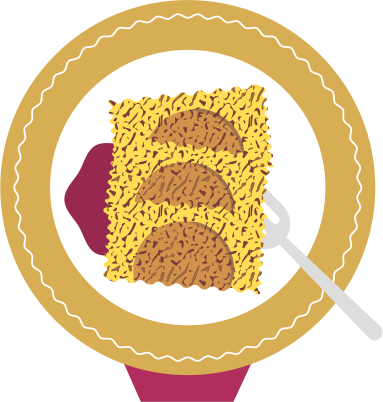


“Here some unload and then fill up their vats, others use their heels to stamp on the grapes and others take the just-boiled wine and catch it in their cups as it gushes out of the tap.” Teofilo Folengo, Il Baldo, 1512.
Lambrusco Mantovano obtained Protected Designation of Origin status in 1987. The specification states that it must be made with 85% grapes from the  Lambrusco Viadanese, Grappello Ruberti, Lambrusco Maestri, Lambrusco Marani and Lambrusco Salamino varieties, with the possible addition of Lambrusco di Sorbara, Grappello Grasparossa, Ancellotta and Fortana up to a maximum of 15%. The wine can be rosecoloured, ruby red or garnet. Its intensity is dependent on the contact of the must, the juice produced in the pressing, with the residual grape skins and seeds which are left for the amount of time necessary to obtain the desired colour. Following the first fermentation, there is a second in-bottle fermentation
Lambrusco Viadanese, Grappello Ruberti, Lambrusco Maestri, Lambrusco Marani and Lambrusco Salamino varieties, with the possible addition of Lambrusco di Sorbara, Grappello Grasparossa, Ancellotta and Fortana up to a maximum of 15%. The wine can be rosecoloured, ruby red or garnet. Its intensity is dependent on the contact of the must, the juice produced in the pressing, with the residual grape skins and seeds which are left for the amount of time necessary to obtain the desired colour. Following the first fermentation, there is a second in-bottle fermentation  controlled by the yeast, which turn the sugars into ethanol and carbon dioxide, making the wine sparkling.
controlled by the yeast, which turn the sugars into ethanol and carbon dioxide, making the wine sparkling.


GRAPE FESTIVAL For many years, wine has been featured here in many different forms. There are many traditional “sùgul” stands where sùgolo – a traditional grape pudding – is prepared like it is at home.

The Grappello Ruberti was recognised as a grape variety in 2013. Before that, it was grouped together with the Viadanese varieties. It is a native variety found mainly in the Oltrepò mantovano. It has a tight cluster, and it is medium in size with a cylindrical, elongated shape. Its grapes are medium sized and rounded. They have a blueblack colour, and a thick and strong skin that is usually covered in bloom.

The turtei sguasarot, whose ancient recipe is closely guarded by the Fraternity of the same name, are tortelli stuffed with chestnuts, mostarda and borlotti beans; they are fried and served with a sauce made from vincotto and plum preserve, in which they wallow around, or sguazzare, as the name implies.
INGREDIENTS FOR THE DOUGH • 500 GR 00 flour • 200 GR water • 12 GR granulated sugar • 12 GR fine salt • olive oil
INGREDIENTS FOR THE FILLING • 200 GR boiled borlotti beans • 200 GR boiled chestnuts • 200 GR mostarda
INGREDIENTS FOR THE SAUCE • 100 GR freshly squeezed orange or tangerine juice • 250 GR vincotto • 250 GR plum conserve
To make the mixture for the filling, which should be firm, finely chop the beans, chestnuts and mostarda and mix it all together.  For the vincotto, wash
For the vincotto, wash  and cook the peeled grapes. Strain the mixture by squeezing the grapes. Reduce it over a low heat
and cook the peeled grapes. Strain the mixture by squeezing the grapes. Reduce it over a low heat  until you are left with around a third of a litre of syrupy liquid. Keep an eye on the pan while cooking so it does not stick or burn. To prepare the tortelli, mix together the flour, water, sugar,
until you are left with around a third of a litre of syrupy liquid. Keep an eye on the pan while cooking so it does not stick or burn. To prepare the tortelli, mix together the flour, water, sugar,  salt and oil. Knead the dough until it is firm. Using a rolling pin,
salt and oil. Knead the dough until it is firm. Using a rolling pin,  roll out the dough until it is around 1 mm in thickness. Use a pastry wheel to cut out rectangles measuring twelve centimetres by seven, and put about 25 g of the filling in the centre. Wet the edges
roll out the dough until it is around 1 mm in thickness. Use a pastry wheel to cut out rectangles measuring twelve centimetres by seven, and put about 25 g of the filling in the centre. Wet the edges  and fold the dough in two. Remove the air from inside the turtel. Fry in hot peanut oil. Allow them to cool, and then dip the tortelli into the sauce.
and fold the dough in two. Remove the air from inside the turtel. Fry in hot peanut oil. Allow them to cool, and then dip the tortelli into the sauce.  Place alternate layers of pasta and sauce in a baking dish. Keep in the refrigerator, and eat after a few days.
Place alternate layers of pasta and sauce in a baking dish. Keep in the refrigerator, and eat after a few days.

IL LAMBRUSCO MANTOVANO
type Sparkling everyday wine
grape Lambrusco
grape yield/hectare 150 quintals
grape yield 65,0%
alcohol content 10,5°
color Ruby red or pink
bouquet Fragrant, intense, distinguishing, aromatic

flavour Dry or sweet, sapid, sparkling
glass That used for an easy everyday red
optimal age 1 year after harvest
serving temperature 14-16° C
combinations Cured meats, pumpkin tortelli if sweet

The rémuage is a series of gradually increasing inclinations which repositions the bottles so that the neck is facing downwards. The fermentation sediments move towards the cork, so that they can later be removed.

There is deeply rooted tradition of sùgolo – a grape pudding – in the Oltrepò, it can be traced back to the sapa used by the Romans. Crushed grapes and sifted must are mixed with white flour and boiled to make a kind of soft pudding which melts in your mouth.
INGREDIENTS FOR 4/6 PEOPLE • 3 KG black grapes • 6 tablespoons of white flour • sugar, if needed
Wash the grapes and  carefully remove them from the
carefully remove them from the  bunch. Put them in a pan and simmer until the skin starts to break. Keep it boiling
bunch. Put them in a pan and simmer until the skin starts to break. Keep it boiling  for about 15 minutes,and when it has cooled, mix in the flour
for about 15 minutes,and when it has cooled, mix in the flour  a little at a time. Stir well. Cook the sùgolo in a saucepan, stirring to prevent the mixture from sticking to the pan. When the sùgolo begins to boil and has the consistency of pudding, pour
a little at a time. Stir well. Cook the sùgolo in a saucepan, stirring to prevent the mixture from sticking to the pan. When the sùgolo begins to boil and has the consistency of pudding, pour  the mixture into pudding moulds. Serve cold as a dessert.
the mixture into pudding moulds. Serve cold as a dessert.